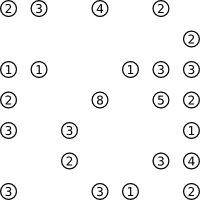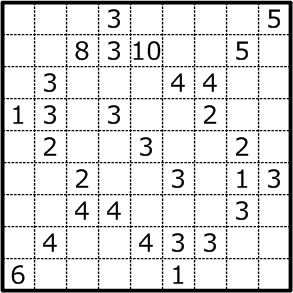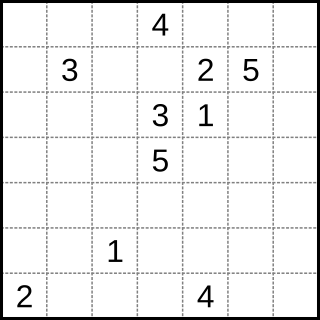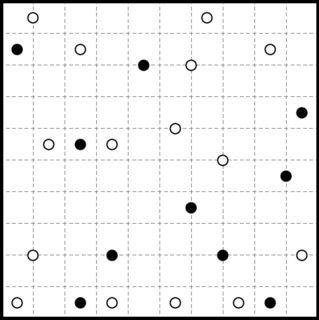This article needs additional citations for verification .(September 2012) |


Bag (also called Corral or Cave) is a binary-determination logic puzzle published by Nikoli.
This article needs additional citations for verification .(September 2012) |


Bag (also called Corral or Cave) is a binary-determination logic puzzle published by Nikoli.
Bag is played on a rectangular grid, usually of dashed lines, in which numbers appear in some of the cells.
The object is to draw a single, continuous loop along the lines of the grid that contains all the numbers on the grid. Each number indicates the total number of cells visible in any orthogonal direction before a line of the loop is reached, plus the cell itself. For example, a 2-cell will have one cell adjacent to it, followed by a wall of the loop.
The easiest starting place is to find a "maximum cell"; that is, a numbered cell which if the walls are not at the maximum distance possible, the number is not satisfied. For example, in a 10x10 grid which has not started to be solved, a 19-cell is a maximum cell, since if the four walls are not at the edges of the grid, the number of cells visible wouldn't be enough. After making some progress, "minimum cells" appear, where if the walls are not at the minimum distance possible, the number is not satisfied.
Many of the solution methods for Bag are very similar to those used for Kuromasu, as the rules are also very similar. The most notable difference is the use of the loop as a part of the solution, as opposed to shaded cells.
Decision question (Friedman, 2002): Does a given instance of Corral Puzzle have a solution? [1]
This decision question is NP-complete. This is proven by reducing the decision problem of deciding the 3-colorability of a planar graph, which is known to be NP-complete, to a Corral Puzzle.

Nonograms, also known as Hanjie, Paint by Numbers, Picross, Griddlers, and Pic-a-Pix, and by various other names, are picture logic puzzles in which cells in a grid must be colored or left blank according to numbers at the side of the grid to reveal a hidden picture. In this puzzle type, the numbers are a form of discrete tomography that measures how many unbroken lines of filled-in squares there are in any given row or column. For example, a clue of "4 8 3" would mean there are sets of four, eight, and three filled squares, in that order, with at least one blank square between successive sets.

Kakuro or Kakkuro or Kakoro is a kind of logic puzzle that is often referred to as a mathematical transliteration of the crossword. Kakuro puzzles are regular features in many math-and-logic puzzle publications across the world. In 1966, Canadian Jacob E. Funk, an employee of Dell Magazines, came up with the original English name Cross Sums and other names such as Cross Addition have also been used, but the Japanese name Kakuro, abbreviation of Japanese kasan kurosu, seems to have gained general acceptance and the puzzles appear to be titled this way now in most publications. The popularity of Kakuro in Japan is immense, second only to Sudoku among Nikoli's famed logic-puzzle offerings.

Sudoku is a logic-based, combinatorial number-placement puzzle. In classic Sudoku, the objective is to fill a 9 × 9 grid with digits so that each column, each row, and each of the nine 3 × 3 subgrids that compose the grid contain all of the digits from 1 to 9. The puzzle setter provides a partially completed grid, which for a well-posed puzzle has a single solution.

Nurikabe is a binary determination puzzle named for Nurikabe, an invisible wall in Japanese folklore that blocks roads and delays foot travel. Nurikabe was apparently invented and named by Nikoli; other names for the puzzle include Cell Structure and Islands in the Stream.
Nikoli Co., Ltd. is a Japanese publisher that specializes in games and, especially, logic puzzles. Nikoli is also the nickname of a quarterly magazine issued by the company in Tokyo. Nikoli was established in 1980 and became prominent worldwide with the popularity of Sudoku.

Hitori is a type of logic puzzle published by Nikoli.

Hashiwokakero is a type of logic puzzle published by Nikoli. It has also been published in English under the name Bridges or Chopsticks. It has also appeared in The Times under the name Hashi. In France, Denmark, the Netherlands, and Belgium it is published under the name Ai-Ki-Ai.

Fillomino (フィルオミノ) is a type of logic puzzle published by many publishers. Other published titles for the puzzle include Allied Occupation.

Masyu is a type of logic puzzle designed and published by Nikoli. The purpose of its creation was to present a puzzle that uses no numbers or letters and yet retains depth and aesthetics.

Heyawake is a binary-determination logic puzzle published by Nikoli. As of 2013, five books consisting entirely of Heyawake puzzles have been published by Nikoli. It first appeared in Puzzle Communication Nikoli #39.

Where are the black cells?, abbreviated Kuromasu or Kurodoko, is a binary-determination logic puzzle published by Nikoli. As of 2005, one book consisting entirely of Kuromasu puzzles has been published by Nikoli.

Slitherlink is a logic puzzle developed by publisher Nikoli.
Light Up, also called Akari, is a binary-determination logic puzzle published by Nikoli. As of 2011, three books consisting entirely of Light Up puzzles have been published by Nikoli.

Numberlink is a type of logic puzzle involving finding paths to connect numbers in a grid.

Gokigen Naname, also known as Slant, is a binary-determination logic puzzle published by Nikoli.
Keisuke is a logic puzzle published by Nikoli.
Yajisan-Kazusan is a binary determination logic puzzle published by Nikoli.

Shakashaka (シャカシャカ) is a logic puzzle developed by publisher Nikoli.

Tentai Show, also known by the names Tentaisho, Galaxies, Spiral Galaxies, or Sym-a-Pix, is a binary-determination logic puzzle published by Nikoli.